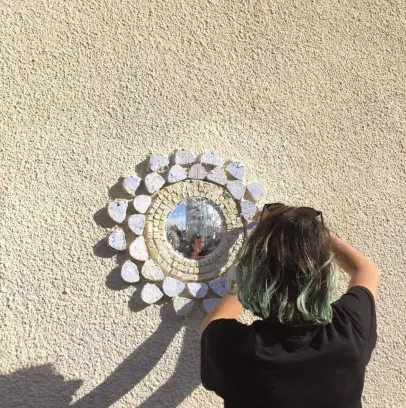Andria’s project is about Fast Fashion Industry and how the current fashion business model has brought an excessive production of garments at a great cost. The project aims to uncover the dark realities behind the fast fashion industry and garment manufacturing in respect to the environment and human exploitation, which are not directly observable by the consumer. The goal is to inspire people into conscious consumerism and consideration of the impact our habits have on the planet and humanity overall.
Andria was selected for the project “European Youth at the frontlines of active citizenship: A Roadmap towards a collective South-North-East-West Momentum” organized by Volunteers Centre Skopje and supported by European Commission due to Erasmus+ European Youth Together programme.

What’s the project about?
– It’s about Fast Fashion Industry and how the current fashion business model has brought an excessive production of garments at a great cost. The project aims to uncover the dark realities behind the fast fashion industry and garment manufacturing in respect to the environment and human exploitation, which are not directly observable by the consumer.
What are you aiming with the project?
– The goal is to inspire people into conscious consumerism and consideration of the impact our habits have on the planet and humanity overall. After addressing those issues, the project will also present the ‘slow fashion’ or conscious model which is a model that gives solutions on how we can consume in a sustainable manner. Specifically, it encourages the visitors to rethink their consumer behavior, to give solutions and invite the visitor to get involved, in order to create a positive impact.
Could you explain what is defined as fast fashion?
– Fast Fashion can be defined as the business model of recreating garments of designer brands at scale, in a quick and inexpensive manufacturing way. Its main purpose is to reproduce current fashion trends to attract the average mainstream producer to buy in low prices. The beginning of this model started in the 80s by Amancio Ortega, founder of Zara, one of the richest people on earth nowadays. The market created by this fashion consumerism model led to an increased release of collections, from two seasons per year (spring and autumn) into 52 seasons per year, something new every week. This philosophy is used by large retails like H&M, TopShop, Primark etc. It is the clothes we buy for the sake of fashion in affodable pricing, in a see now buy now mentality in order to catch up with high fashion standards which we are overly exposed by the media. Most of those clothes are been used three times or less before they end up in landfills.
Which are the main differences between fast and slow fashion?
– Slow fashion takes a look in the importance of the clothes quality in order to give longer life to the garment. Aims to reduce production and waste by reuse fabrics, encouraging people to buy second hand clothing and buy from local brands. Fast Fashion focuses on fast and mass production, with no consideration of whether the practices have been violating human rights and creating environmental distraction. In comparison to slow fashion that focuses in sustainable and ethical fashion.
What is the impact of fast fashion industry in the environment?
– Because of the increased consumption of garments, the fashion Industry has become responsible for 20% of global wastewater and 10% of global carbon emission. In 2015, textile production created more greenhouse gases than international flights and maritime shipping combined. River pollution caused by the textile dyeing process, a case is the Citarum River in Indonesia where the toxic chemicals in the rivers water that use to sustain the community needs, have caused health problems to children. To sum up, is one of the industries that right now came to the point of consuming such a great amount of natural resources which live behind catastrophic prints on the earth.
What gave rise to the slow fashion movement?
– Human rights are been violated in textile factories, including dangerous work conditions, long hours, child labor, and instances of modern slavery. One incidence that marked the beginning of ‘Who made my clothes’ movement, on April 2013 Dhaka garment factory (Rana Plaza) in Bangladesh collapsed and killed 1,134 workers, which is considered the deadliest garment factory disaster in history. The building had severe faults in the structure and was not suitable to hold factory machines, the owners ignored the inappropriate conditions even after the warning, a day after the building collapsed.
Why is it important for people to be aware of this knowledge?
– The average consumer is now purchasing 60% more items of clothing than 20 years ago unaware of the consequences, 85% of textiles end in landfills or incinerators – 60% within a year of being made. Is important to stop treating clothing as disposable, and give the appropriate respect. Is important to understand how many resources it required for the garment. This could only be achieved by a collective change in decreasing excessive consumerism habits and a cultural shift towards sustainable fashion.
What change you want to see with this project?
– It is important to shift the market demands/place in order to fight unethical practices towards textile factory workers in third world countries, to give a voice to the people that we as communities continue to sustain their oppression. Help the earth to heal by reusing the already existing materials we have and to stop abusing natural resources. I am wishing to see more conscious consumers in the future, more compassion towards the Earth and the people behind the veil of industry.
Andria Spyrou

